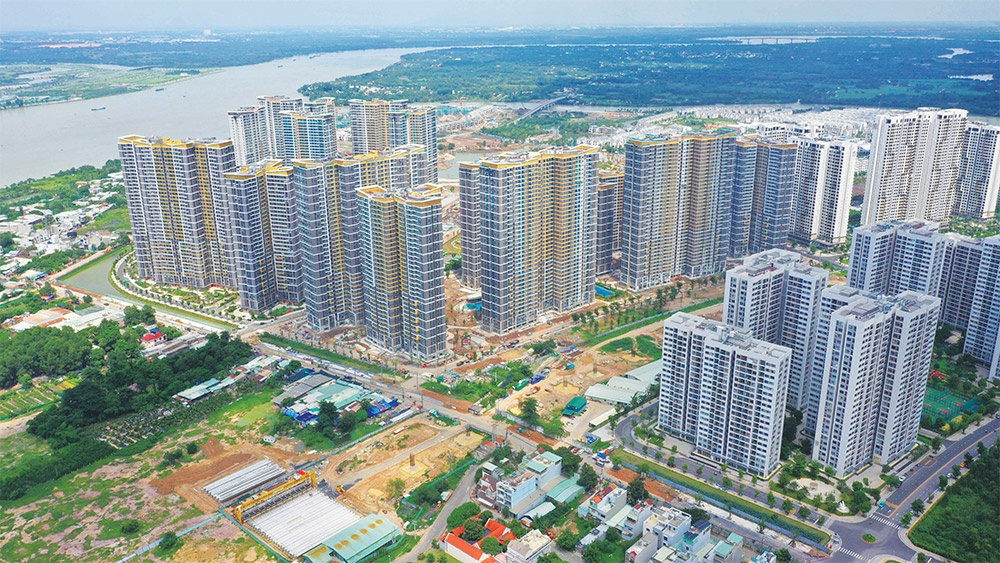Hung Yen borders Hanoi and has an advantageous transport infrastructure with connections to seaports, airports and major urban centres. To leverage these strengths, the province is focusing resources on building industrial park infrastructure to attract investment.
Building technical infrastructure for industrial parks
At the Industrial Park No. 3 construction site, workers are rushing to complete the technical infrastructure. Nguyen Cong Hong, General Director of TDH Ecoland, said, “To overcome difficulties, Hung Yen established a steering committee for site clearance of key projects, making this process smoother. Within a short time, all 160 hectares of Industrial Park No. 3 was handed over to the investor.”
Immediately after the land was cleared, TDH Ecoland and its partners focused on building technical infrastructure. In less than a year, Industrial Park No. 3 has essentially completed its technical infrastructure and begun operations. With its advantageous location adjacent to the Hanoi-Hai Phong Expressway, and particularly the policy of one-time land rental payments, it has drawn many FDI investment projects.
Hung Yen Province occupies a strategic position in the Northern Key Economic Region, bordering Hanoi, with convenient transport infrastructure, including the Hanoi-Hai Phong Expressway, National Highways 5, 38, 39, and Hanoi’s Ring Road 4, connecting to seaports, airports and major northern urban centres. To capitalise on these advantages and create breakthrough economic development, the province has consistently focused on industrial park infrastructure development to attract investment.
Vu Quoc Nghi, Head of the Hung Yen Industrial Parks Management Board, shared that to create favourable conditions for industrial park infrastructure construction, since 2021, the Provincial Party Committee Standing Board issued a directive on site clearance for infrastructure projects and a decision on establishing a steering committee for key projects during the 2021-2025 period, led by the Provincial Party Secretary. The province has mobilised the entire political system to persuade residents to agree to hand over land for socio-economic development projects.
The steering committee for key projects meets monthly to review site clearance progress and issues directives to promptly resolve difficulties and obstacles. Consequently, between 2021 and 2024, the province cleared nearly 1,300 hectares of land for industrial park infrastructure development, almost triple the total area from 2015 to 2020.
Industrial park developers have accelerated construction and invested in comprehensive technical infrastructure. In 2024, approximately 620 hectares of land were developed, nearly double from 2023, which brings the total area of industrial parks with technical infrastructure to about 2,500 hectares, representing 89% of the total area, with approximately 540 hectares remaining available for lease. Many industrial parks have become operational and attracted investment, notably the Thang Long II Industrial Park expansion, Industrial Park No. 3, Industrial Park No. 5, and the Clean Industrial Park.
Integrated industrial park infrastructure has facilitated effective investment attraction. In 2024, Hung Yen Province received 86 projects, a 33% increase from 2023, with a total registered capital of 772 million USD and 11.6 trillion VND.
The industrial parks have attracted many large high-tech projects. Notable examples include Nitto Vietnam’s 132 million USD project to manufacture LCD polarising films for smartphones and automobiles, Molex Vietnam’s 128 million USD project to produce optical cables and high-speed connection cables, and Arizon Vietnam’s 67.5 million USD project manufacturing RFID labels.
Creating momentum for breakthrough growth
According to the Prime Minister’s decision on industrial park development planning to 2030 with a vision for 2050, Hung Yen Province will have 35 industrial parks with a total area exceeding 12,000 hectares. Currently, the province has 12 industrial parks covering more than 3,123 hectares. Of these, 10 industrial parks (approximately 2,773 hectares) are operational and accepting secondary investment projects.
Hung Yen Party Secretary Nguyen Huu Nghia shared that 2024 was a record year for the province’s investment attraction, with 180 projects totalling over 61 trillion VND and more than 1.5 billion USD. To date, the province has 2,371 active projects (1,755 domestic and 616 foreign) with total registered capital exceeding 370 trillion VND and over 8.5 billion USD.
This achievement is significantly owed to the industrial parks’ contribution to attracting investment and helping drive high and stable economic growth for the province. In 2024, the province’s economy grew by 7.7% to 159.8 trillion VND and GDP per capita reached 121.3 million VND, up 8.8 million VND compared to 2023.
To achieve breakthrough development strategic goals, Nghia stated that the province is determined to pursue a new growth model based on pillars, including the enabling role of government, focusing on promoting strong digital transformation, continuously improving institutions, investment environment, business climate and competitiveness, and strengthening the leading role of public investment.
Simultaneously, the province will establish an ecosystem for clean, high-tech industrial development with selective new investment attraction policies that prioritise scale, modern technology, and environmental protection.
Hung Yen is also accelerating urbanisation, developing large, smart, ecological urban areas linked with modern trade and services development, improving provincial competitiveness, and creating favourable conditions for businesses and investors to have equal access to information, business opportunities, investment and land.
Hung Yen leaders regularly maintain contact and dialogue with businesses to promptly identify and address difficulties and obstacles facing them, strengthen investment and trade promotion activities, promote potential and business opportunities, and build the province’s brand and image domestically and internationally.
In the coming period, the province will focus on reviewing and updating land use plans for industrial parks to be developed according to the master plan and adding newly established industrial parks to the list of provincial key projects.
Provincial functional agencies have been directed to accelerate compensation, site clearance and land handover to industrial park investors for technical infrastructure construction and project reception.
They are also increasing the implementation pace of approved industrial park infrastructure investment projects, striving to have approximately 2,000 hectares of cleared land ready for lease by the end of 2025.
The province aims to have 30 industrial parks (9,588 hectares) by 2030 and 35 (over 12,000 hectares) by 2050, transforming Hung Yen into one of Vietnam’s strongest industrially developed provinces.








